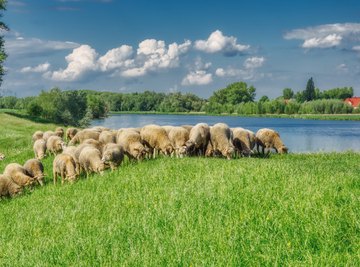
Animals fall into three distinct groups based upon what they eat. This is a natural way to often group animals. Plant eaters are herbivores, meat eaters are carnivores, and animals that eat both plants and animals are omnivores. What an animal uses for fuel can often clue biologists into a other information about it and how each it in its native ecosystem.
Herbivores
Any animal that eats only plants will be classified as an herbivore. Just because they don't eat meat doesn't mean all herbivores are small. Guinea pigs, rabbits, snails and butterflies are all good examples of small herbivores, but horses, cows, zebras, deer and elephants are herbivores, as well. In prehistoric times, many dinosaurs ate only plants and they reached gigantic proportions. Many different types of animals can be herbivores, including mammals, insects, worms, invertebrates and even some birds.
Carnivores
Any animal that sustains itself solely on meat is classified as a carnivore. Carnivores often have sharper teeth or even fangs to help tear up flesh. Most of the time in their ecosystem, carnivores will prey on herbivores though they may eat omnivores or even other carnivores depending on what food is available. Small carnivores can include spiders, frogs and bats. Medium-size carnivores might include larger birds, such as eagles and hawks, snakes, and anteaters. Large carnivores range from wild dogs and wolves to large predators like lions, tigers or crocodiles.
Omnivores
Any animal that can eat both plants and animals is an omnivore. People are omnivores, containing with flat and sharp teeth and the ability to digest meat, fruit, and vegetables for food. Bears are another example of omnivores as they eat both berries and meat. Medium-size omnivores include animals like raccoons, pigs and chickens.
Teeth
Often, teeth can be a giveaway as to what category an animal fits. This isn't always the case, but herbivores more typically have flatter teeth for grinding up vegetation, while carnivores will have sharp teeth for tearing up meat. Many omnivores will have some combination of the two, allowing for easier eating and digestion of their food sources.
References
About the Author
Monty Dayton is a professional freelance writer who has worked for the ACLU, Touchstone Publishing LLC, the University of Alaska, Fairbanks and many other employers. He holds a Master of Fine Arts in creative writing from the University of Alaska and loves writing about travel, the outdoors and health topics.
